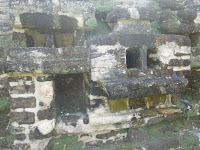 |
| Punta Gorda |
I arrived by the Pop
bus-line to Punta Gorda, after a two night visit with a Ketchi Maya family in Indian
Creek, Toledo District. I left the small
village in the pouring rain as I waved to the naked little girl who ran out of
her house to bid me farewell. My
experience in Indian Creek was very profound and personal so I won’t write
about it here but I feel very blessed to have made new friends there.
 When I got off the bus in Punta Gorda, I agreed to accept the
help of a local man, who insisted on walking me to find my hotel and then
insisted on getting the $6 BZE that the taxi would have charged me, so he could
buy milk … hmmm. I gave it to him. The same fellow tried to get money from me
later, forgetting he already had. That time I said, no. I checked into the
Charlton Inn. It was ok for one night, but not worth the money unless you must
have a flat screen TV with a million channels. I desired a different experience,
so rather than stay the 4 nights I initially intended, it didn’t take me long
to start calling an alternative.
When I got off the bus in Punta Gorda, I agreed to accept the
help of a local man, who insisted on walking me to find my hotel and then
insisted on getting the $6 BZE that the taxi would have charged me, so he could
buy milk … hmmm. I gave it to him. The same fellow tried to get money from me
later, forgetting he already had. That time I said, no. I checked into the
Charlton Inn. It was ok for one night, but not worth the money unless you must
have a flat screen TV with a million channels. I desired a different experience,
so rather than stay the 4 nights I initially intended, it didn’t take me long
to start calling an alternative. 
I reserved a stay at Hickatee Cottages, about a mile out
of town. Ian and Kate are the owners: an English couple, who have been coming
to Belize for almost thirty years and have been at Hickatee, permanently for
nine. The place was exactly what my soul needed; a quiet, jungle retreat with
howler monkeys “roaring” and “barking” in the distance.
Hickatee guests are invited to record when they hear or
see the howler monkeys and at what direction and distance. I heard them several
times but the loudest was at 2:30 am. I
left the sanctity of my lovely room and ventured outside in the dark, to get a more
accurate recording. The data is part of a study taking place by a university in
the States.
The property itself has private walking trails with plant
and tree species marked and a reference manual to take with you on your 25 or
45 minute hike. My hike was unfortunately halted by rain and flooded trails, so
I didn’t get very far, but far enough to enjoy the sounds and coolness under
the jungle canopy. A gentle little stream passes through the property as well. Ian
told me there are 40 types of orchids growing on the property. I saw a few in
bloom. If the weather would have been warmer and drier, I would have taken
advantage of the plunge pool that lies in the middle of the beautiful garden.
Varying continental breakfast was served on the main
veranda, after complimentary coffee was delivered by Ian, to my veranda, at the
precise time I arranged. Perfect! Dinners
were by reservation at breakfast. I had calaloo soup one evening that was the
greenest soup I have ever eaten. The meals and rum punch were delicious as were
the traditional thin English pancakes served with lime and sugar.
Ian and Kate also maintain a wonderful library of books
featuring Belize, and Garifuna music that plays softly in the background. The
couple are a wealth of information and they shared it openly with me. They have
also been studying the bats on the property and provide an ultrasonic speaker
that picks up the bat activity during nightfall. Couldn’t see the bats but I
could hear them. Ian is able to identify the type of bat by its unique
frequency. There are an abundance of species that live here. Ian can tell you
how many as the number escapes me. That was cool!
I am happy I treated myself to this small establishment
whose philosophy is minimal impact to the environment and maximum benefit to their
adopted community. You can read more about this on their website. www.hickatee.com
I hope to return one day for another stay.
Additional info:
Cab ride one-way from Punta Gorda – 20 BZE however, Ian
will pick you up upon arrival and return you when leaving. While it is only a
mile from town, it is a slow, pot hole filled drive. It is the rain forest
after all.















